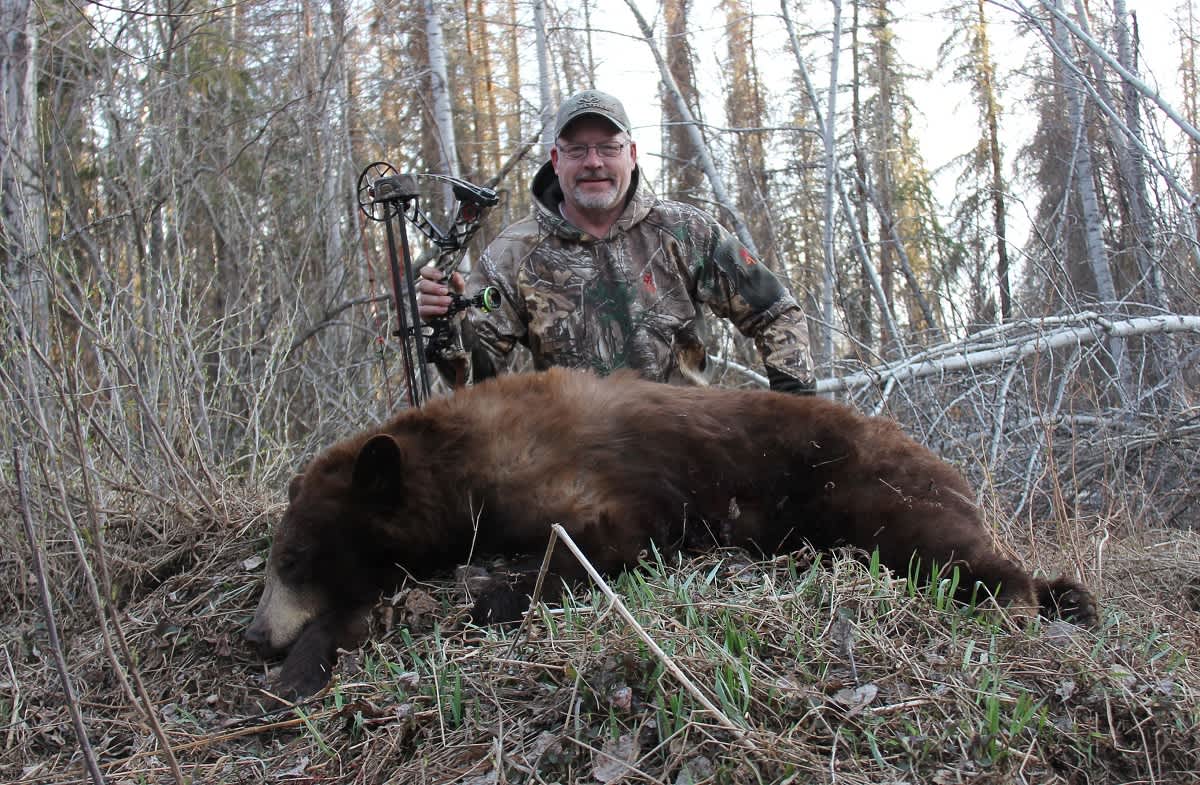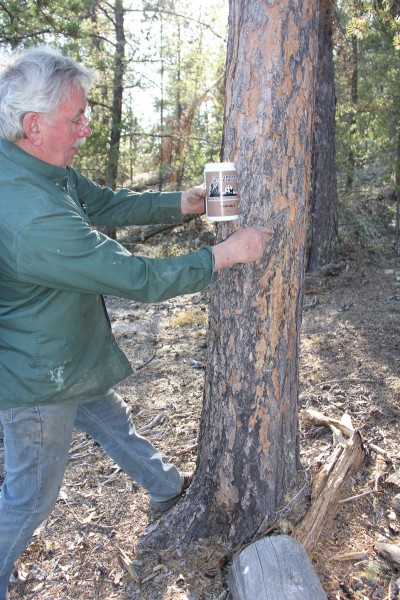Chasing the Black Bear Grand Slam
Bernie Barringer 06.11.14

Sheep hunters have their grand slam, archers have the bowhunting super slam, even whitetail hunters have the whitetail slam. Shouldn’t black bear hunters have a grand slam?
I have no idea how many people have actually killed one of each of the four major color phases of black bears. I suspect it’s a very small number, and the number of hunters who have achieved a “black bear grand slam” with a bow is even smaller yet. I am trying to be one of those hunters and on May 19, 2014, I bagged a cinnamon color phase bear which gave me the third of the four colors. Here’s a little about that hunt and some more information about the black bear’s unique color variations.
While there are almost an infinite number of colors of black bears, each of the colors can be lumped into four major categories: chocolate, blonde, cinnamon, and black. Black bears as a species are mostly black, which stands to reason, and if you draw a line right down the middle of North America, the bears east of that line are almost entirely black, with extremely rare exceptions.

West of that line, the color variations start showing up. There are pockets of the various colors in different parts of the West. I have bagged 16 black bears with a bow, 13 of them black. I shot a chocolate bear in northwestern Minnesota, and I have shot blacks from Idaho to Maine and from British Columbia to Ontario. My search for a cinnamon or blonde has been a long road. I hunted areas with cinnamons in Idaho, Manitoba, British Columbia, and finally got the cinnamon on my second trip to Saskatchewan. Here’s how it happened.
I booked the hunt with Thunder Mountain Outfitters after researching areas with a high percentage of cinnamon color phase bears. Laurie Thorson operates the outfitting business in a large exclusive area south of La Ronge Saskatchewan. He has a dozens of excellent bait sites he has maintained for many years. He claims that about 30 percent of the bears in his area are colors other than black. That’s a pretty high percentage, and the majority of the colors are cinnamon. These factors influenced my decision to hunt with Laurie.
I shared camp that week with Don Prescott from Michigan, who has hunted with Laurie for 20 straight seasons and shot 20 bears. In 20 years he has bagged a grand slam of colors (though not with a bow) at this outfitter. That’s a remarkable feat. Two cinnamon bears had showed up on the trail cameras prior to my arrival, so I was optimistic.
The first night I had the opportunity to shoot a chocolate color phase bear with a beautiful coat. It was lighter on the top and dark on the legs and head. It was not a large bear but was tempting, and if I wasn’t specifically hunting a cinnamon I would have considered ending my hunt right there. The bear entertained me by tearing up logs looking for grubs and even biting off the strap that held my ladder to the tree. I took some great video of it, which can be seen in the footage embedded below.

The second evening I moved to another site and enjoyed watching a sow with a yearling cub. The trail cameras were checked at several baits and one bait site showed two cinnamons visiting it on a regular basis. I would be placed at that bait for my third evening.
There are many misconceptions about baiting bears. One of them is that you just throw out a pile of bait and shoot the bear when he walks up. Bear baiting is a science and mature black bears are difficult to shoot. If it weren’t for baits, they would be utterly unmanageable in many habitats. The bear that came in on day three was a perfect example.
The bear approached from downwind of the bait and spent 15 minutes looking over the area, smelling the air. I could see him back in the brush, and he was the reddish brown color I had been dreaming of. My cinnamon bear was in sight! But the wind betrayed me and after an anguishing period of watching him, he left. If I had been hunting with a gun, my hunt would be over, but with a bow it’s a lot more of a challenge. This was the third time I could have shot a cinnamon if I’d been carrying a gun.
Twenty minutes later he appeared again like a phantom in the same spot. He sat and tested the wind for long, tedious moments; he stood up and looked the area over often, then left once more. He repeated this one more time over the next half hour. I sat perfectly still while he was there, only standing to stretch my legs and get the blood flowing when he would leave. I felt my chances of getting a shot before dark were slim, but I held onto a spark of hope.
An hour and a half after I first saw the bear, he appeared for the fourth time. The sun was sinking low behind the trees and the wind had switched just a little. This time he spent his 15 minutes in that spot looking, but finally not smelling or seeing me. Eventually he committed to the bait, moving ever so slowly, choosing each footstep carefully. As he went through areas where the sunlight shined on his pelt, the sight of the beautiful red tint to his coat made my heart pound. Would I finally get my chance?
When he got to the bait his head went behind the bait barrel long enough for me to draw my bow, and when he stepped out a put an arrow through the back of the lungs at 23 yards. The bear ran 50 yards and piled up within sight. Just like that, I finally had my cinnamon bear. I got it all on video and when I turned the video on myself, I got a little emotional about all the hundreds of hours of hunting and thousands of miles of travelling I had put into this one moment.
Now it’s time to look ahead to finishing this quest. The Rocky Mountain West has the most blonde bears. There are pockets of them in Utah, Wyoming, Idaho, Alberta, and even Arizona. I am already researching where I should go try for one. It’s a tall order, since less than five percent of bears are blonde. But somewhere out there is a blonde phase black bear with my name on it, and when I find him, I hope to do what only a small handful of people have done before: hit the grand slam of color bears.
Follow Bernie’s bowhunting adventures on his blog, bowhuntingroad.com.

